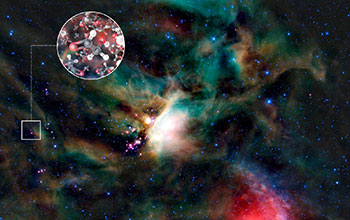Multimedia Gallery
Sugar Molecules in Gas Surrounding Young, Sun-like Star
A team of astronomers has found molecules of glycolaldehyde--a simple form of sugar--in the gas surrounding a young binary star called IRAS 16293-2422, with similar mass to the sun. This is the first time sugar has been found in space around such a star. The discovery shows that the building blocks of life are in the right place at the right time for inclusion in planets forming around the star. The astronomers used the Atacama Large Millimeter/submillimeter Array (ALMA) to detect the molecules.
This image shows the Rho Ophiuchi star-forming region in infrared light, as seen by NASA's Wide-field Infrared Explorer (WISE). IRAS 16293-2422 is the red object in the center of the small square. The inset image is an artist's impression of glycolaldehyde molecules and shows glycolaldehyde's molecular structure (C2H4O2). Carbon atoms are gray, oxygen atoms are red and hydrogen atoms are white. In the main infrared image, blue and cyan represent light emitted at wavelengths of 3.4 and 4.6 micrometers, which is predominantly from stars. Green and red represent light from 12 and 22 micrometers, respectively, which is mostly emitted by dust.
ALMA is an international astronomy facility that is a partnership of Europe, North America and East Asia in cooperation with the Republic of Chile. It is funded in part by the National Science Foundation. To learn more, visit the ALMA website. (Date of Image: unknown)
Credit: ESO/L. Calçada and NASA/JPL-Caltech/WISE Team
Special Restrictions: Before using this image, please read the ALMA "Terms of Use."
Images and other media in the National Science Foundation Multimedia Gallery are available for use in print and electronic material by NSF employees, members of the media, university staff, teachers and the general public. All media in the gallery are intended for personal, educational and nonprofit/non-commercial use only.
Images credited to the National Science Foundation, a federal agency, are in the public domain. The images were created by employees of the United States Government as part of their official duties or prepared by contractors as "works for hire" for NSF. You may freely use NSF-credited images and, at your discretion, credit NSF with a "Courtesy: National Science Foundation" notation.
Additional information about general usage can be found in Conditions.
Also Available:
Download the high-resolution JPG version of the image. (1.4 MB)
Use your mouse to right-click (Mac users may need to Ctrl-click) the link above and choose the option that will save the file or target to your computer.



